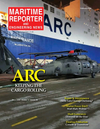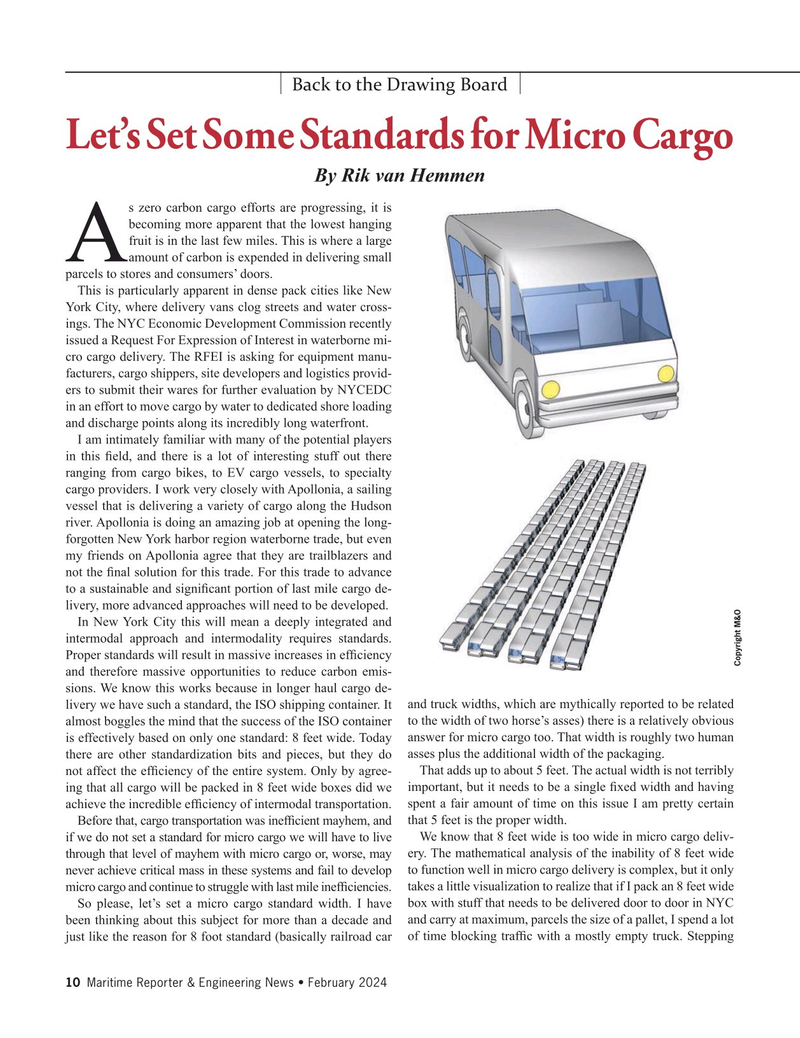
Page 10: of Maritime Reporter Magazine (February 2024)
Read this page in Pdf, Flash or Html5 edition of February 2024 Maritime Reporter Magazine
Back to the Drawing Board
Let’s Set Some Standards for Micro Cargo
By Rik van Hemmen s zero carbon cargo efforts are progressing, it is becoming more apparent that the lowest hanging fruit is in the last few miles. This is where a large amount of carbon is expended in delivering small
A parcels to stores and consumers’ doors.
This is particularly apparent in dense pack cities like New
York City, where delivery vans clog streets and water cross- ings. The NYC Economic Development Commission recently issued a Request For Expression of Interest in waterborne mi- cro cargo delivery. The RFEI is asking for equipment manu- facturers, cargo shippers, site developers and logistics provid- ers to submit their wares for further evaluation by NYCEDC in an effort to move cargo by water to dedicated shore loading and discharge points along its incredibly long waterfront.
I am intimately familiar with many of the potential players in this ? eld, and there is a lot of interesting stuff out there ranging from cargo bikes, to EV cargo vessels, to specialty cargo providers. I work very closely with Apollonia, a sailing vessel that is delivering a variety of cargo along the Hudson river. Apollonia is doing an amazing job at opening the long- forgotten New York harbor region waterborne trade, but even my friends on Apollonia agree that they are trailblazers and not the ? nal solution for this trade. For this trade to advance to a sustainable and signi? cant portion of last mile cargo de- livery, more advanced approaches will need to be developed.
In New York City this will mean a deeply integrated and intermodal approach and intermodality requires standards.
Proper standards will result in massive increases in ef? ciency
Copyright M&O and therefore massive opportunities to reduce carbon emis- sions. We know this works because in longer haul cargo de- livery we have such a standard, the ISO shipping container. It and truck widths, which are mythically reported to be related almost boggles the mind that the success of the ISO container to the width of two horse’s asses) there is a relatively obvious is effectively based on only one standard: 8 feet wide. Today answer for micro cargo too. That width is roughly two human there are other standardization bits and pieces, but they do asses plus the additional width of the packaging.
not affect the ef? ciency of the entire system. Only by agree- That adds up to about 5 feet. The actual width is not terribly ing that all cargo will be packed in 8 feet wide boxes did we important, but it needs to be a single ? xed width and having achieve the incredible ef? ciency of intermodal transportation. spent a fair amount of time on this issue I am pretty certain
Before that, cargo transportation was inef? cient mayhem, and that 5 feet is the proper width. if we do not set a standard for micro cargo we will have to live We know that 8 feet wide is too wide in micro cargo deliv- through that level of mayhem with micro cargo or, worse, may ery. The mathematical analysis of the inability of 8 feet wide never achieve critical mass in these systems and fail to develop to function well in micro cargo delivery is complex, but it only micro cargo and continue to struggle with last mile inef? ciencies. takes a little visualization to realize that if I pack an 8 feet wide
So please, let’s set a micro cargo standard width. I have box with stuff that needs to be delivered door to door in NYC been thinking about this subject for more than a decade and and carry at maximum, parcels the size of a pallet, I spend a lot just like the reason for 8 foot standard (basically railroad car of time blocking traf? c with a mostly empty truck. Stepping 10 Maritime Reporter & Engineering News • February 2024
MR #2 (1-17).indd 10 2/6/2024 12:01:26 PM

 9
9

 11
11
